Reflective Analysis Report: MGT601 Dynamic Leadership at University
VerifiedAdded on 2022/09/02
|9
|2190
|13
Report
AI Summary
This report is a self-reflective analysis of a student's leadership journey, focusing on their role as a team leader in a psychology research project. The report delves into the student's leadership style, highlighting the adoption of transformational leadership inspired by a mentor. It analyzes the results of a Gallup StrengthsFinder test, identifying strengths such as empathy, emotional control, and adaptability, while also acknowledging the challenges of perfectionism. The report examines the implications of feedback received from peers, recognizing the positive impact of communication skills and emotional intelligence. The student reflects on their experience, discussing conflict resolution, time management, and the importance of fostering a shared vision within the team. Recommendations are provided for continued professional development, emphasizing the importance of self-confidence, emotional intelligence, and the pursuit of research goals. The report concludes with a reflection on the learning experience and the aspiration to further develop leadership skills.
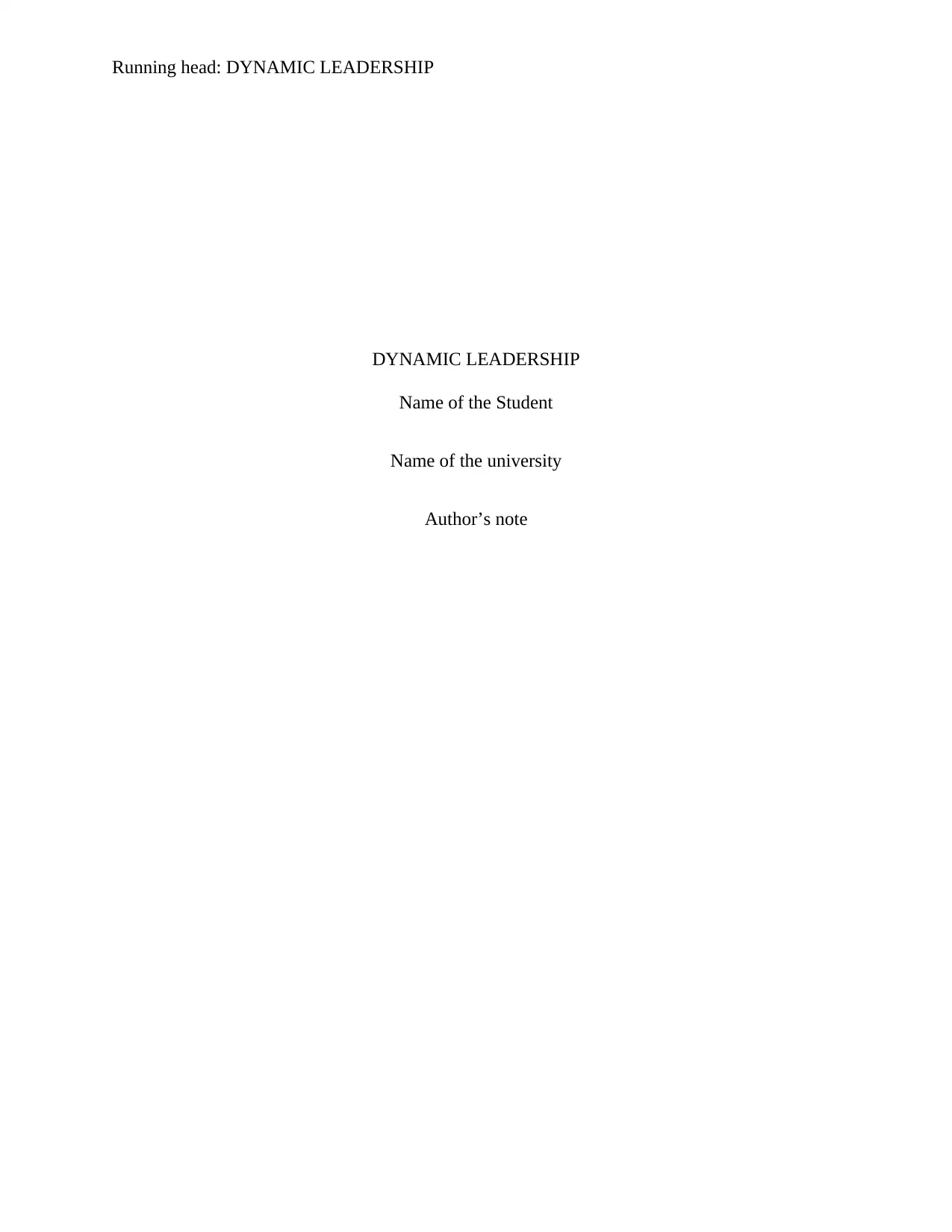
Running head: DYNAMIC LEADERSHIP
DYNAMIC LEADERSHIP
Name of the Student
Name of the university
Author’s note
DYNAMIC LEADERSHIP
Name of the Student
Name of the university
Author’s note
Paraphrase This Document
Need a fresh take? Get an instant paraphrase of this document with our AI Paraphraser
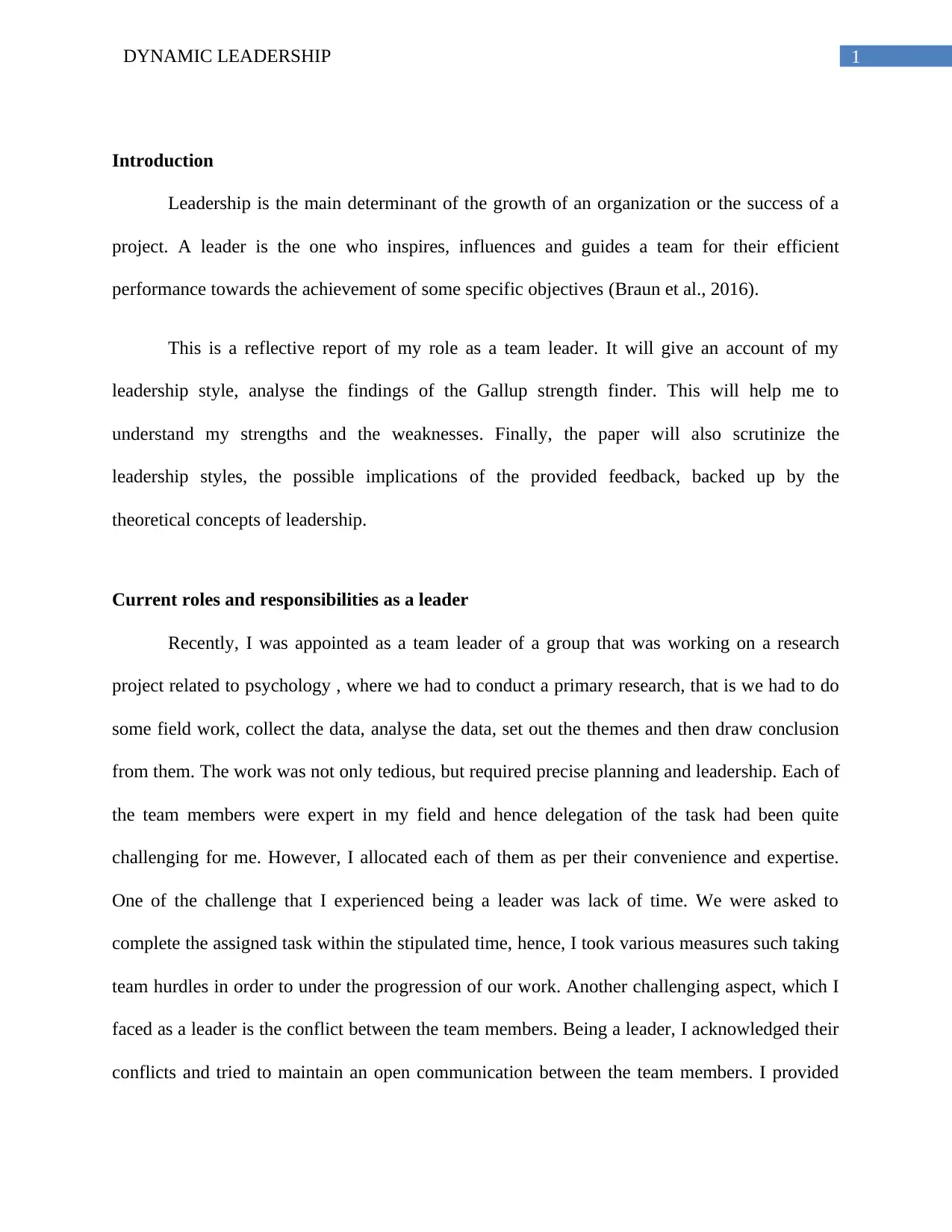
1DYNAMIC LEADERSHIP
Introduction
Leadership is the main determinant of the growth of an organization or the success of a
project. A leader is the one who inspires, influences and guides a team for their efficient
performance towards the achievement of some specific objectives (Braun et al., 2016).
This is a reflective report of my role as a team leader. It will give an account of my
leadership style, analyse the findings of the Gallup strength finder. This will help me to
understand my strengths and the weaknesses. Finally, the paper will also scrutinize the
leadership styles, the possible implications of the provided feedback, backed up by the
theoretical concepts of leadership.
Current roles and responsibilities as a leader
Recently, I was appointed as a team leader of a group that was working on a research
project related to psychology , where we had to conduct a primary research, that is we had to do
some field work, collect the data, analyse the data, set out the themes and then draw conclusion
from them. The work was not only tedious, but required precise planning and leadership. Each of
the team members were expert in my field and hence delegation of the task had been quite
challenging for me. However, I allocated each of them as per their convenience and expertise.
One of the challenge that I experienced being a leader was lack of time. We were asked to
complete the assigned task within the stipulated time, hence, I took various measures such taking
team hurdles in order to under the progression of our work. Another challenging aspect, which I
faced as a leader is the conflict between the team members. Being a leader, I acknowledged their
conflicts and tried to maintain an open communication between the team members. I provided
Introduction
Leadership is the main determinant of the growth of an organization or the success of a
project. A leader is the one who inspires, influences and guides a team for their efficient
performance towards the achievement of some specific objectives (Braun et al., 2016).
This is a reflective report of my role as a team leader. It will give an account of my
leadership style, analyse the findings of the Gallup strength finder. This will help me to
understand my strengths and the weaknesses. Finally, the paper will also scrutinize the
leadership styles, the possible implications of the provided feedback, backed up by the
theoretical concepts of leadership.
Current roles and responsibilities as a leader
Recently, I was appointed as a team leader of a group that was working on a research
project related to psychology , where we had to conduct a primary research, that is we had to do
some field work, collect the data, analyse the data, set out the themes and then draw conclusion
from them. The work was not only tedious, but required precise planning and leadership. Each of
the team members were expert in my field and hence delegation of the task had been quite
challenging for me. However, I allocated each of them as per their convenience and expertise.
One of the challenge that I experienced being a leader was lack of time. We were asked to
complete the assigned task within the stipulated time, hence, I took various measures such taking
team hurdles in order to under the progression of our work. Another challenging aspect, which I
faced as a leader is the conflict between the team members. Being a leader, I acknowledged their
conflicts and tried to maintain an open communication between the team members. I provided
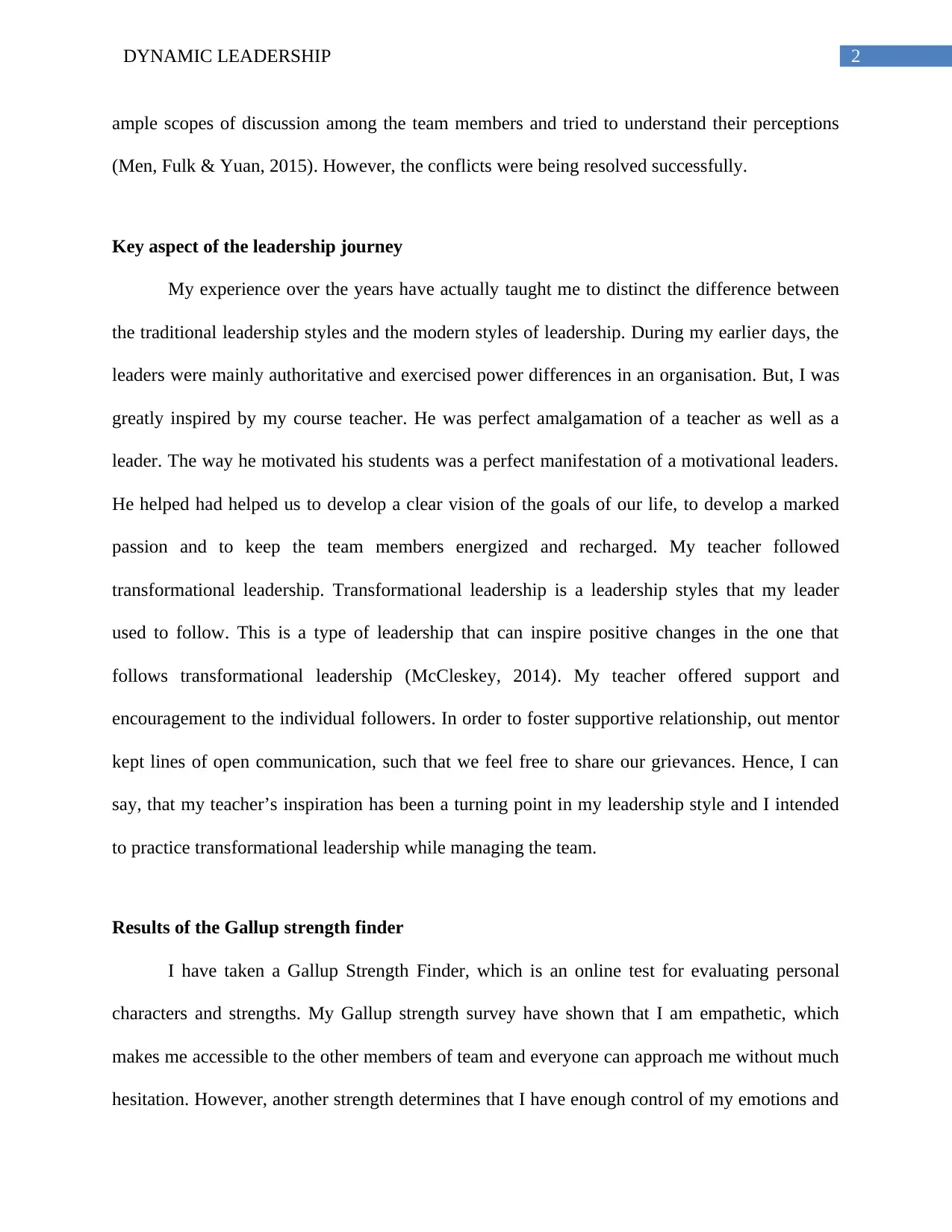
2DYNAMIC LEADERSHIP
ample scopes of discussion among the team members and tried to understand their perceptions
(Men, Fulk & Yuan, 2015). However, the conflicts were being resolved successfully.
Key aspect of the leadership journey
My experience over the years have actually taught me to distinct the difference between
the traditional leadership styles and the modern styles of leadership. During my earlier days, the
leaders were mainly authoritative and exercised power differences in an organisation. But, I was
greatly inspired by my course teacher. He was perfect amalgamation of a teacher as well as a
leader. The way he motivated his students was a perfect manifestation of a motivational leaders.
He helped had helped us to develop a clear vision of the goals of our life, to develop a marked
passion and to keep the team members energized and recharged. My teacher followed
transformational leadership. Transformational leadership is a leadership styles that my leader
used to follow. This is a type of leadership that can inspire positive changes in the one that
follows transformational leadership (McCleskey, 2014). My teacher offered support and
encouragement to the individual followers. In order to foster supportive relationship, out mentor
kept lines of open communication, such that we feel free to share our grievances. Hence, I can
say, that my teacher’s inspiration has been a turning point in my leadership style and I intended
to practice transformational leadership while managing the team.
Results of the Gallup strength finder
I have taken a Gallup Strength Finder, which is an online test for evaluating personal
characters and strengths. My Gallup strength survey have shown that I am empathetic, which
makes me accessible to the other members of team and everyone can approach me without much
hesitation. However, another strength determines that I have enough control of my emotions and
ample scopes of discussion among the team members and tried to understand their perceptions
(Men, Fulk & Yuan, 2015). However, the conflicts were being resolved successfully.
Key aspect of the leadership journey
My experience over the years have actually taught me to distinct the difference between
the traditional leadership styles and the modern styles of leadership. During my earlier days, the
leaders were mainly authoritative and exercised power differences in an organisation. But, I was
greatly inspired by my course teacher. He was perfect amalgamation of a teacher as well as a
leader. The way he motivated his students was a perfect manifestation of a motivational leaders.
He helped had helped us to develop a clear vision of the goals of our life, to develop a marked
passion and to keep the team members energized and recharged. My teacher followed
transformational leadership. Transformational leadership is a leadership styles that my leader
used to follow. This is a type of leadership that can inspire positive changes in the one that
follows transformational leadership (McCleskey, 2014). My teacher offered support and
encouragement to the individual followers. In order to foster supportive relationship, out mentor
kept lines of open communication, such that we feel free to share our grievances. Hence, I can
say, that my teacher’s inspiration has been a turning point in my leadership style and I intended
to practice transformational leadership while managing the team.
Results of the Gallup strength finder
I have taken a Gallup Strength Finder, which is an online test for evaluating personal
characters and strengths. My Gallup strength survey have shown that I am empathetic, which
makes me accessible to the other members of team and everyone can approach me without much
hesitation. However, another strength determines that I have enough control of my emotions and
⊘ This is a preview!⊘
Do you want full access?
Subscribe today to unlock all pages.

Trusted by 1+ million students worldwide

3DYNAMIC LEADERSHIP
I intend to make decisions based on proper evidences. However, I feel that I have enough
flexibility and adaptability, which is most important in managing a team. My optimistic nature
helps me to overcome adverse situations and helps me to motivate my team members in times of
crisis. My perfectionist attitude had set a higher standard for myself. My, this quality has helped
to deliver perfect work and I tend to channelize my ideas to my team members. However, I
always believe in team work and always seek feedback from my team members before proposing
my ideas. Some of the signature themes that I have found out are futuristic, maximizer and focus.
I intend to maximise my skills by focussing on my skills and helping my other team members to
bring out the best out of them. I believe that I am focussed of the futuristic goals and thrive to
develop a shared goal for the other team members. Apart from seeking the short term goals, I
aim for long term goals, and my futuristic thoughts have always helped me and my team to
withstand any crisis related to our work or job.
Leadership style, capabilities, effectiveness
As stated in the above sections, I believe in transformational leadership style.
Transformational leadership represents the leadership style where the leaders broaden their
interest for elevating the interests of the employees for generating awareness and acceptance of
the performance and the mission of the group (Dwyer et al., 2013). Leaders acts as stimulants
that impetus the individuals to have a shared common goals- for the betterment of the
organization (in this case our project) (Ghadi, Fernando & Caputi, 2013). Transformational
leaders tends to improve their leadership skills by seeking proactive feedback from their peers
and by giving honest feedback about the employees (Soltwisch, & Krahnke, 2017). Although
most of the leaders are born charismatic, but one has to imbibe the transformational leadership
skills among them, hence seeking feedback provides the potential for the improvement (Men,
I intend to make decisions based on proper evidences. However, I feel that I have enough
flexibility and adaptability, which is most important in managing a team. My optimistic nature
helps me to overcome adverse situations and helps me to motivate my team members in times of
crisis. My perfectionist attitude had set a higher standard for myself. My, this quality has helped
to deliver perfect work and I tend to channelize my ideas to my team members. However, I
always believe in team work and always seek feedback from my team members before proposing
my ideas. Some of the signature themes that I have found out are futuristic, maximizer and focus.
I intend to maximise my skills by focussing on my skills and helping my other team members to
bring out the best out of them. I believe that I am focussed of the futuristic goals and thrive to
develop a shared goal for the other team members. Apart from seeking the short term goals, I
aim for long term goals, and my futuristic thoughts have always helped me and my team to
withstand any crisis related to our work or job.
Leadership style, capabilities, effectiveness
As stated in the above sections, I believe in transformational leadership style.
Transformational leadership represents the leadership style where the leaders broaden their
interest for elevating the interests of the employees for generating awareness and acceptance of
the performance and the mission of the group (Dwyer et al., 2013). Leaders acts as stimulants
that impetus the individuals to have a shared common goals- for the betterment of the
organization (in this case our project) (Ghadi, Fernando & Caputi, 2013). Transformational
leaders tends to improve their leadership skills by seeking proactive feedback from their peers
and by giving honest feedback about the employees (Soltwisch, & Krahnke, 2017). Although
most of the leaders are born charismatic, but one has to imbibe the transformational leadership
skills among them, hence seeking feedback provides the potential for the improvement (Men,
Paraphrase This Document
Need a fresh take? Get an instant paraphrase of this document with our AI Paraphraser
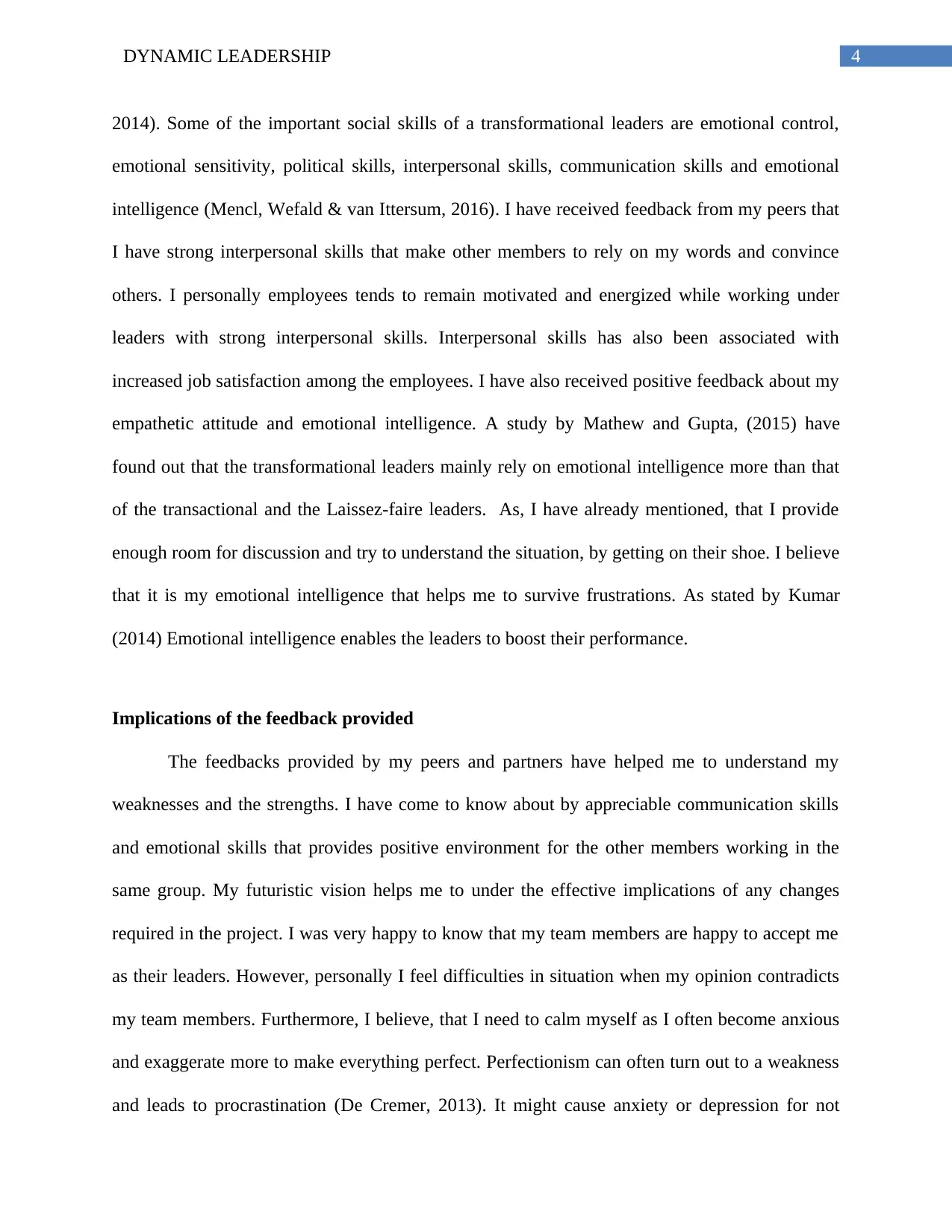
4DYNAMIC LEADERSHIP
2014). Some of the important social skills of a transformational leaders are emotional control,
emotional sensitivity, political skills, interpersonal skills, communication skills and emotional
intelligence (Mencl, Wefald & van Ittersum, 2016). I have received feedback from my peers that
I have strong interpersonal skills that make other members to rely on my words and convince
others. I personally employees tends to remain motivated and energized while working under
leaders with strong interpersonal skills. Interpersonal skills has also been associated with
increased job satisfaction among the employees. I have also received positive feedback about my
empathetic attitude and emotional intelligence. A study by Mathew and Gupta, (2015) have
found out that the transformational leaders mainly rely on emotional intelligence more than that
of the transactional and the Laissez-faire leaders. As, I have already mentioned, that I provide
enough room for discussion and try to understand the situation, by getting on their shoe. I believe
that it is my emotional intelligence that helps me to survive frustrations. As stated by Kumar
(2014) Emotional intelligence enables the leaders to boost their performance.
Implications of the feedback provided
The feedbacks provided by my peers and partners have helped me to understand my
weaknesses and the strengths. I have come to know about by appreciable communication skills
and emotional skills that provides positive environment for the other members working in the
same group. My futuristic vision helps me to under the effective implications of any changes
required in the project. I was very happy to know that my team members are happy to accept me
as their leaders. However, personally I feel difficulties in situation when my opinion contradicts
my team members. Furthermore, I believe, that I need to calm myself as I often become anxious
and exaggerate more to make everything perfect. Perfectionism can often turn out to a weakness
and leads to procrastination (De Cremer, 2013). It might cause anxiety or depression for not
2014). Some of the important social skills of a transformational leaders are emotional control,
emotional sensitivity, political skills, interpersonal skills, communication skills and emotional
intelligence (Mencl, Wefald & van Ittersum, 2016). I have received feedback from my peers that
I have strong interpersonal skills that make other members to rely on my words and convince
others. I personally employees tends to remain motivated and energized while working under
leaders with strong interpersonal skills. Interpersonal skills has also been associated with
increased job satisfaction among the employees. I have also received positive feedback about my
empathetic attitude and emotional intelligence. A study by Mathew and Gupta, (2015) have
found out that the transformational leaders mainly rely on emotional intelligence more than that
of the transactional and the Laissez-faire leaders. As, I have already mentioned, that I provide
enough room for discussion and try to understand the situation, by getting on their shoe. I believe
that it is my emotional intelligence that helps me to survive frustrations. As stated by Kumar
(2014) Emotional intelligence enables the leaders to boost their performance.
Implications of the feedback provided
The feedbacks provided by my peers and partners have helped me to understand my
weaknesses and the strengths. I have come to know about by appreciable communication skills
and emotional skills that provides positive environment for the other members working in the
same group. My futuristic vision helps me to under the effective implications of any changes
required in the project. I was very happy to know that my team members are happy to accept me
as their leaders. However, personally I feel difficulties in situation when my opinion contradicts
my team members. Furthermore, I believe, that I need to calm myself as I often become anxious
and exaggerate more to make everything perfect. Perfectionism can often turn out to a weakness
and leads to procrastination (De Cremer, 2013). It might cause anxiety or depression for not
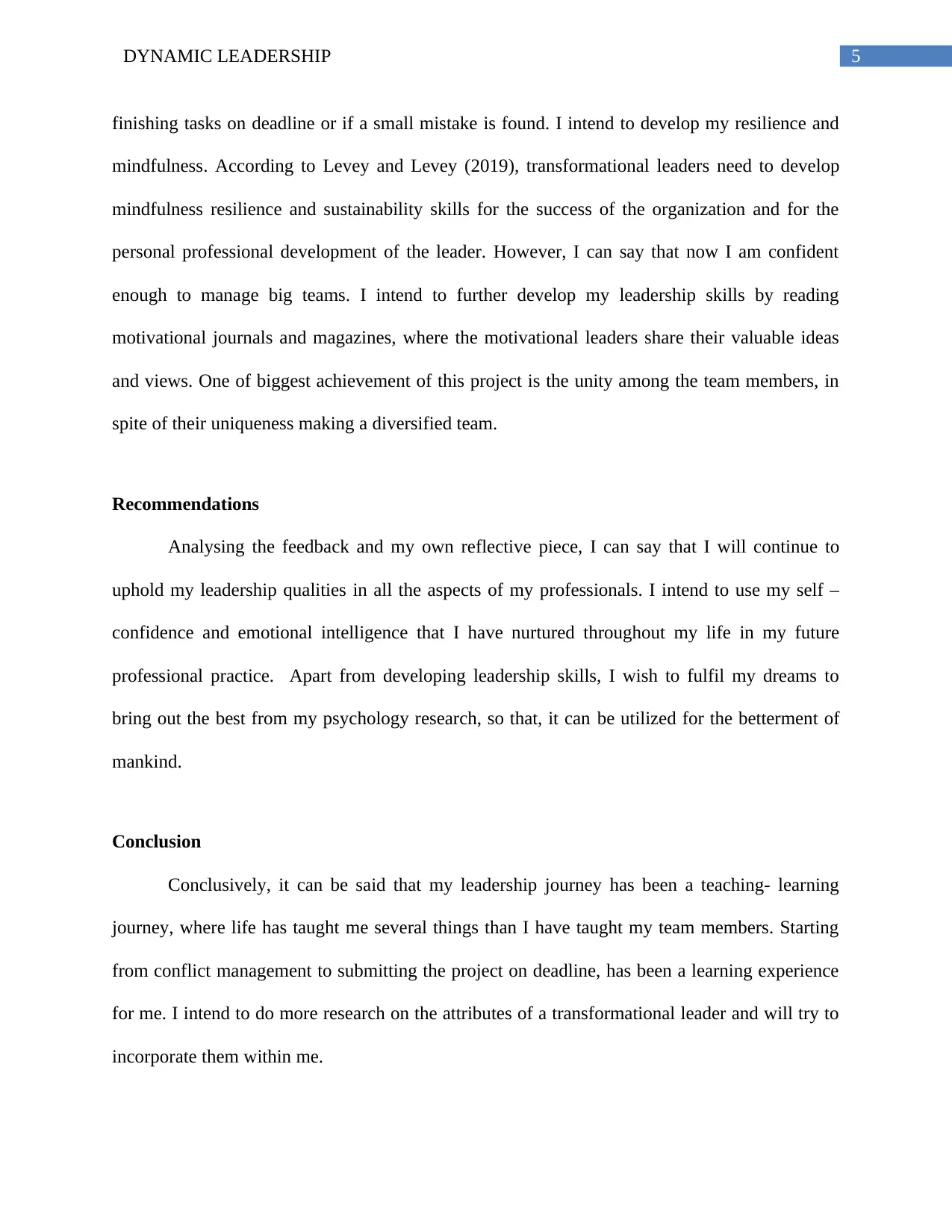
5DYNAMIC LEADERSHIP
finishing tasks on deadline or if a small mistake is found. I intend to develop my resilience and
mindfulness. According to Levey and Levey (2019), transformational leaders need to develop
mindfulness resilience and sustainability skills for the success of the organization and for the
personal professional development of the leader. However, I can say that now I am confident
enough to manage big teams. I intend to further develop my leadership skills by reading
motivational journals and magazines, where the motivational leaders share their valuable ideas
and views. One of biggest achievement of this project is the unity among the team members, in
spite of their uniqueness making a diversified team.
Recommendations
Analysing the feedback and my own reflective piece, I can say that I will continue to
uphold my leadership qualities in all the aspects of my professionals. I intend to use my self –
confidence and emotional intelligence that I have nurtured throughout my life in my future
professional practice. Apart from developing leadership skills, I wish to fulfil my dreams to
bring out the best from my psychology research, so that, it can be utilized for the betterment of
mankind.
Conclusion
Conclusively, it can be said that my leadership journey has been a teaching- learning
journey, where life has taught me several things than I have taught my team members. Starting
from conflict management to submitting the project on deadline, has been a learning experience
for me. I intend to do more research on the attributes of a transformational leader and will try to
incorporate them within me.
finishing tasks on deadline or if a small mistake is found. I intend to develop my resilience and
mindfulness. According to Levey and Levey (2019), transformational leaders need to develop
mindfulness resilience and sustainability skills for the success of the organization and for the
personal professional development of the leader. However, I can say that now I am confident
enough to manage big teams. I intend to further develop my leadership skills by reading
motivational journals and magazines, where the motivational leaders share their valuable ideas
and views. One of biggest achievement of this project is the unity among the team members, in
spite of their uniqueness making a diversified team.
Recommendations
Analysing the feedback and my own reflective piece, I can say that I will continue to
uphold my leadership qualities in all the aspects of my professionals. I intend to use my self –
confidence and emotional intelligence that I have nurtured throughout my life in my future
professional practice. Apart from developing leadership skills, I wish to fulfil my dreams to
bring out the best from my psychology research, so that, it can be utilized for the betterment of
mankind.
Conclusion
Conclusively, it can be said that my leadership journey has been a teaching- learning
journey, where life has taught me several things than I have taught my team members. Starting
from conflict management to submitting the project on deadline, has been a learning experience
for me. I intend to do more research on the attributes of a transformational leader and will try to
incorporate them within me.
⊘ This is a preview!⊘
Do you want full access?
Subscribe today to unlock all pages.

Trusted by 1+ million students worldwide
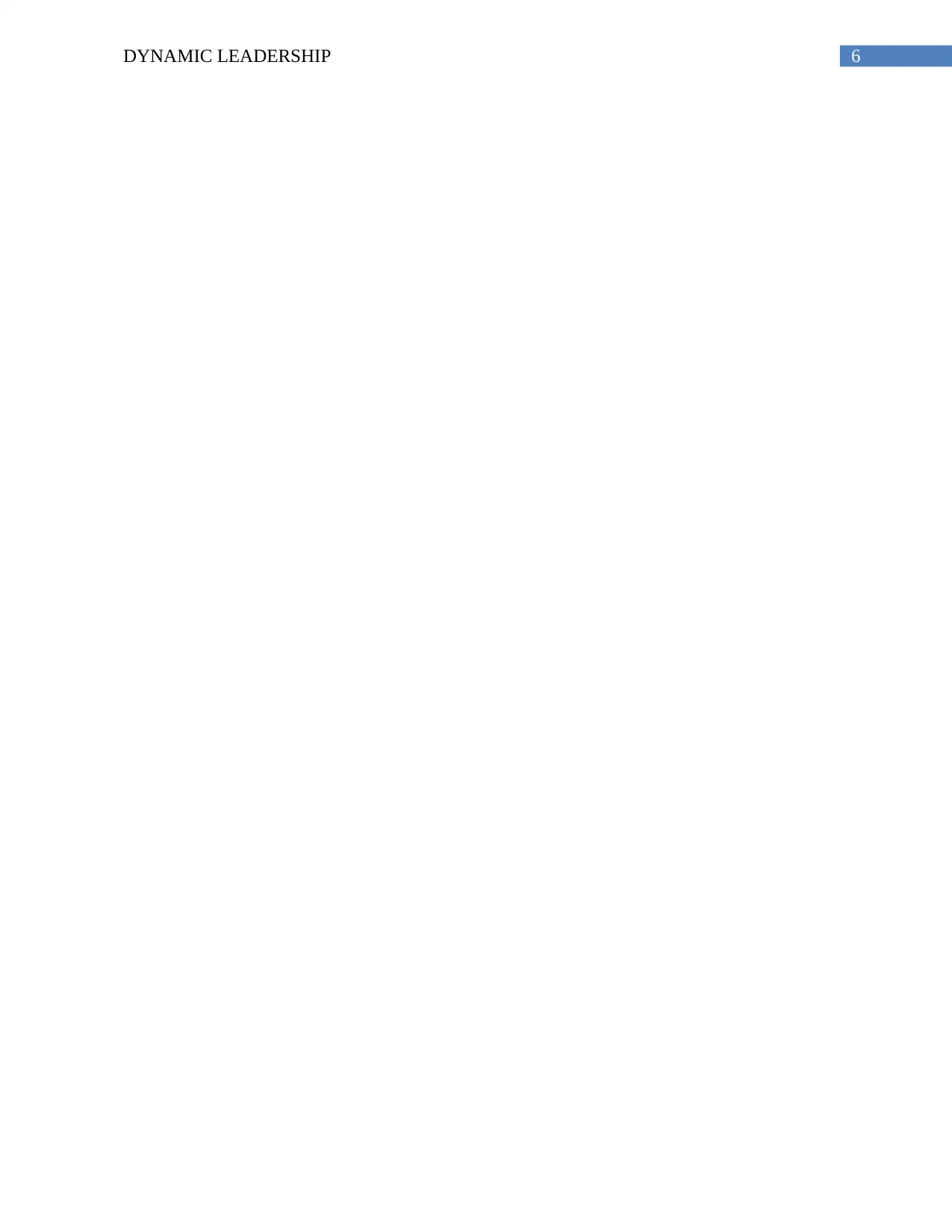
6DYNAMIC LEADERSHIP
Paraphrase This Document
Need a fresh take? Get an instant paraphrase of this document with our AI Paraphraser
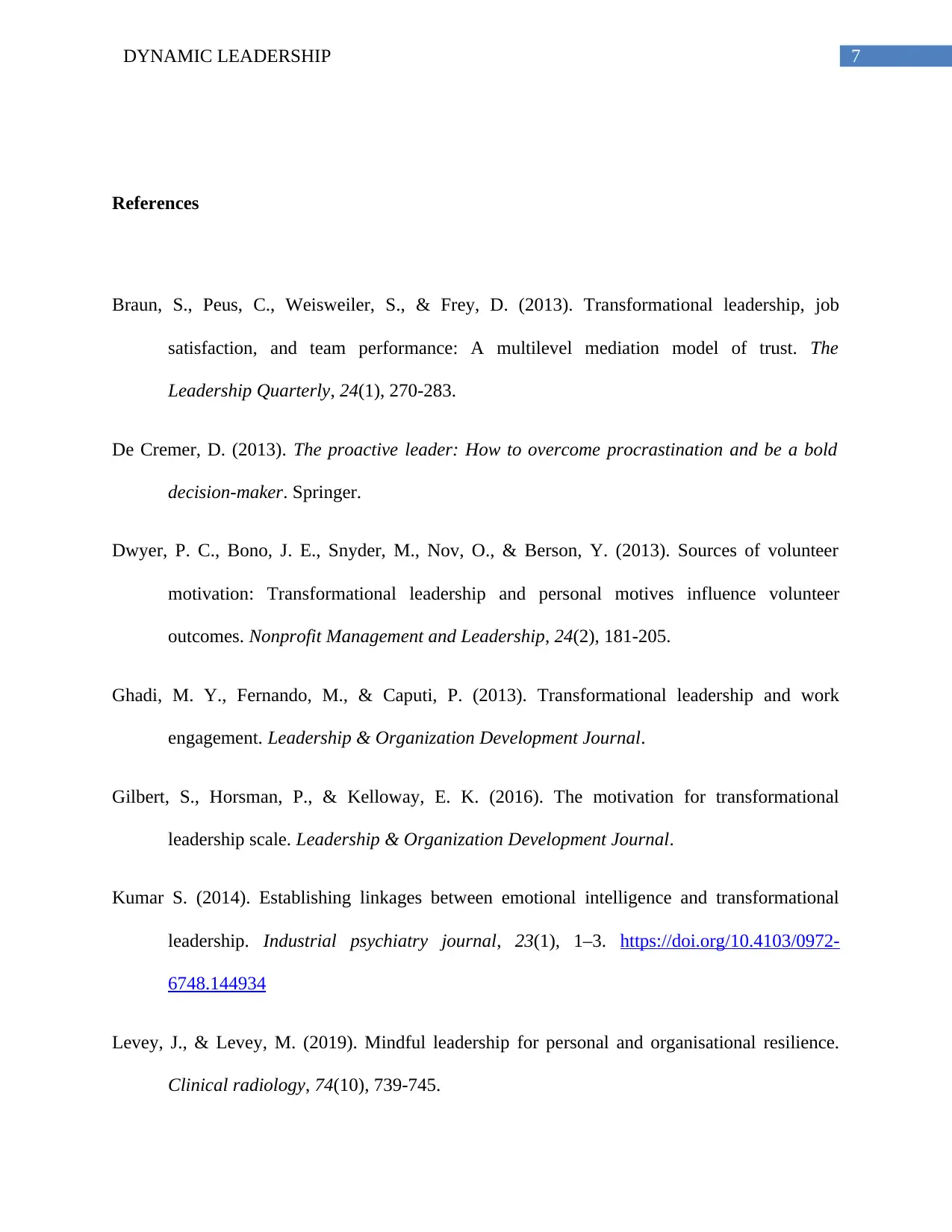
7DYNAMIC LEADERSHIP
References
Braun, S., Peus, C., Weisweiler, S., & Frey, D. (2013). Transformational leadership, job
satisfaction, and team performance: A multilevel mediation model of trust. The
Leadership Quarterly, 24(1), 270-283.
De Cremer, D. (2013). The proactive leader: How to overcome procrastination and be a bold
decision-maker. Springer.
Dwyer, P. C., Bono, J. E., Snyder, M., Nov, O., & Berson, Y. (2013). Sources of volunteer
motivation: Transformational leadership and personal motives influence volunteer
outcomes. Nonprofit Management and Leadership, 24(2), 181-205.
Ghadi, M. Y., Fernando, M., & Caputi, P. (2013). Transformational leadership and work
engagement. Leadership & Organization Development Journal.
Gilbert, S., Horsman, P., & Kelloway, E. K. (2016). The motivation for transformational
leadership scale. Leadership & Organization Development Journal.
Kumar S. (2014). Establishing linkages between emotional intelligence and transformational
leadership. Industrial psychiatry journal, 23(1), 1–3. https://doi.org/10.4103/0972-
6748.144934
Levey, J., & Levey, M. (2019). Mindful leadership for personal and organisational resilience.
Clinical radiology, 74(10), 739-745.
References
Braun, S., Peus, C., Weisweiler, S., & Frey, D. (2013). Transformational leadership, job
satisfaction, and team performance: A multilevel mediation model of trust. The
Leadership Quarterly, 24(1), 270-283.
De Cremer, D. (2013). The proactive leader: How to overcome procrastination and be a bold
decision-maker. Springer.
Dwyer, P. C., Bono, J. E., Snyder, M., Nov, O., & Berson, Y. (2013). Sources of volunteer
motivation: Transformational leadership and personal motives influence volunteer
outcomes. Nonprofit Management and Leadership, 24(2), 181-205.
Ghadi, M. Y., Fernando, M., & Caputi, P. (2013). Transformational leadership and work
engagement. Leadership & Organization Development Journal.
Gilbert, S., Horsman, P., & Kelloway, E. K. (2016). The motivation for transformational
leadership scale. Leadership & Organization Development Journal.
Kumar S. (2014). Establishing linkages between emotional intelligence and transformational
leadership. Industrial psychiatry journal, 23(1), 1–3. https://doi.org/10.4103/0972-
6748.144934
Levey, J., & Levey, M. (2019). Mindful leadership for personal and organisational resilience.
Clinical radiology, 74(10), 739-745.
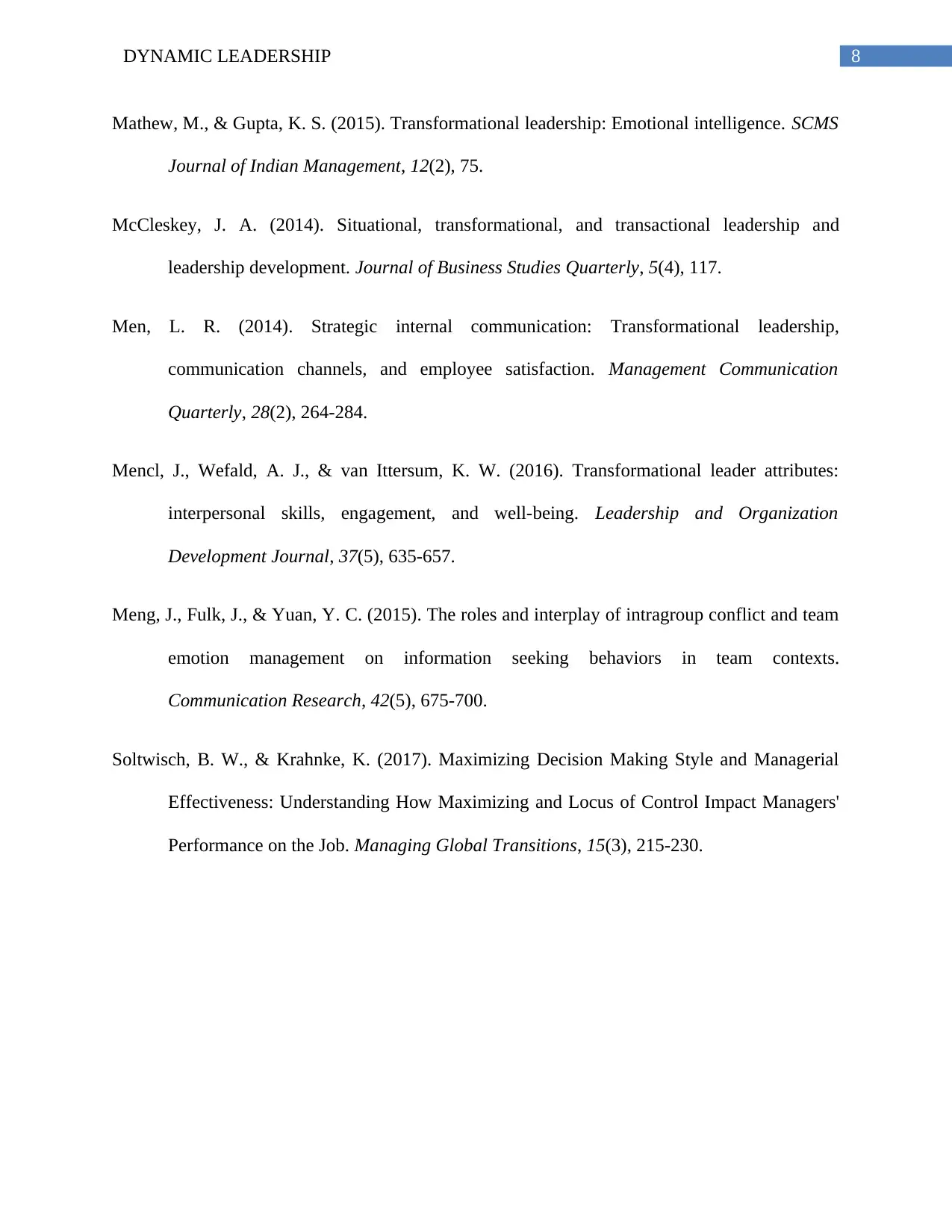
8DYNAMIC LEADERSHIP
Mathew, M., & Gupta, K. S. (2015). Transformational leadership: Emotional intelligence. SCMS
Journal of Indian Management, 12(2), 75.
McCleskey, J. A. (2014). Situational, transformational, and transactional leadership and
leadership development. Journal of Business Studies Quarterly, 5(4), 117.
Men, L. R. (2014). Strategic internal communication: Transformational leadership,
communication channels, and employee satisfaction. Management Communication
Quarterly, 28(2), 264-284.
Mencl, J., Wefald, A. J., & van Ittersum, K. W. (2016). Transformational leader attributes:
interpersonal skills, engagement, and well-being. Leadership and Organization
Development Journal, 37(5), 635-657.
Meng, J., Fulk, J., & Yuan, Y. C. (2015). The roles and interplay of intragroup conflict and team
emotion management on information seeking behaviors in team contexts.
Communication Research, 42(5), 675-700.
Soltwisch, B. W., & Krahnke, K. (2017). Maximizing Decision Making Style and Managerial
Effectiveness: Understanding How Maximizing and Locus of Control Impact Managers'
Performance on the Job. Managing Global Transitions, 15(3), 215-230.
Mathew, M., & Gupta, K. S. (2015). Transformational leadership: Emotional intelligence. SCMS
Journal of Indian Management, 12(2), 75.
McCleskey, J. A. (2014). Situational, transformational, and transactional leadership and
leadership development. Journal of Business Studies Quarterly, 5(4), 117.
Men, L. R. (2014). Strategic internal communication: Transformational leadership,
communication channels, and employee satisfaction. Management Communication
Quarterly, 28(2), 264-284.
Mencl, J., Wefald, A. J., & van Ittersum, K. W. (2016). Transformational leader attributes:
interpersonal skills, engagement, and well-being. Leadership and Organization
Development Journal, 37(5), 635-657.
Meng, J., Fulk, J., & Yuan, Y. C. (2015). The roles and interplay of intragroup conflict and team
emotion management on information seeking behaviors in team contexts.
Communication Research, 42(5), 675-700.
Soltwisch, B. W., & Krahnke, K. (2017). Maximizing Decision Making Style and Managerial
Effectiveness: Understanding How Maximizing and Locus of Control Impact Managers'
Performance on the Job. Managing Global Transitions, 15(3), 215-230.
⊘ This is a preview!⊘
Do you want full access?
Subscribe today to unlock all pages.

Trusted by 1+ million students worldwide
1 out of 9
Related Documents
Your All-in-One AI-Powered Toolkit for Academic Success.
+13062052269
info@desklib.com
Available 24*7 on WhatsApp / Email
![[object Object]](/_next/static/media/star-bottom.7253800d.svg)
Unlock your academic potential
Copyright © 2020–2025 A2Z Services. All Rights Reserved. Developed and managed by ZUCOL.




